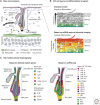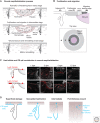Plasticity of Epithelial Cells during Skin Wound Healing
- PMID: 36376081
- PMCID: PMC10153802
- DOI: 10.1101/cshperspect.a041232
Plasticity of Epithelial Cells during Skin Wound Healing
Abstract
Epithelial tissues line the outer surfaces of the mammalian body and protect from external harm. In skin, the epithelium is maintained by distinct stem cell populations residing in the interfollicular epidermis and various niches of the hair follicle. These stem cells give rise to the stratified epidermal layers and the protective hair coat, while being confined to their respective niches. Upon injury, however, all stem cell progenies can leave their niche and collectively contribute to a central wound healing process, called reepithelialization, for restoring the skin's barrier function. This review explores how epithelial cells from distinct niches respond and adapt during acute wound repair. We discuss when and where cells sense and react to damage, how cellular identity is regulated at the molecular and behavioral level, and how cells memorize past experiences and their origin. This collective knowledge highlights cellular plasticity as a brilliant feature of epithelial tissues to heal.
Copyright © 2023 Cold Spring Harbor Laboratory Press; all rights reserved.
Figures




References
-
- Adam RC, Yang H, Ge Y, Infarinato NR, Gur-Cohen S, Miao Y, Wang P, Zhao Y, Lu CP, Kim JE, et al. 2020. NFI transcription factors provide chromatin access to maintain stem cell identity while preventing unintended lineage fate choices. Nat Cell Biol 22: 640–650. 10.1038/s41556-020-0513-0 - DOI - PMC - PubMed
Publication types
MeSH terms
Grants and funding
LinkOut - more resources
Full Text Sources
Miscellaneous
